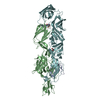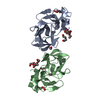+ Open data
Open data
- Basic information
Basic information
| Entry | Database: PDB / ID: 6nk5 | ||||||
|---|---|---|---|---|---|---|---|
| Title | Electron Cryo-Microscopy Of Chikungunya VLP | ||||||
 Components Components |
| ||||||
 Keywords Keywords | VIRUS LIKE PARTICLE / Chikungunya / virus-like particle / Structural Genomics / Center for Structural Genomics of Infectious Diseases / CSGID | ||||||
| Function / homology |  Function and homology information Function and homology informationtogavirin / T=4 icosahedral viral capsid / symbiont-mediated suppression of host toll-like receptor signaling pathway / host cell cytoplasm / serine-type endopeptidase activity / fusion of virus membrane with host endosome membrane / symbiont entry into host cell / virion attachment to host cell / host cell nucleus / host cell plasma membrane ...togavirin / T=4 icosahedral viral capsid / symbiont-mediated suppression of host toll-like receptor signaling pathway / host cell cytoplasm / serine-type endopeptidase activity / fusion of virus membrane with host endosome membrane / symbiont entry into host cell / virion attachment to host cell / host cell nucleus / host cell plasma membrane / virion membrane / structural molecule activity / proteolysis / RNA binding / membrane Similarity search - Function | ||||||
| Biological species |   Chikungunya virus Chikungunya virus | ||||||
| Method | ELECTRON MICROSCOPY / single particle reconstruction / cryo EM / Resolution: 4.16 Å | ||||||
 Authors Authors | Basore, K. / Fremont, D.H. / Center for Structural Genomics of Infectious Diseases (CSGID) | ||||||
| Funding support |  United States, 1items United States, 1items
| ||||||
 Citation Citation |  Journal: Cell / Year: 2019 Journal: Cell / Year: 2019Title: Cryo-EM Structure of Chikungunya Virus in Complex with the Mxra8 Receptor. Authors: Katherine Basore / Arthur S Kim / Christopher A Nelson / Rong Zhang / Brittany K Smith / Carla Uranga / Lo Vang / Ming Cheng / Michael L Gross / Jonathan Smith / Michael S Diamond / Daved H Fremont /  Abstract: Mxra8 is a receptor for multiple arthritogenic alphaviruses that cause debilitating acute and chronic musculoskeletal disease in humans. Herein, we present a 2.2 Å resolution X-ray crystal ...Mxra8 is a receptor for multiple arthritogenic alphaviruses that cause debilitating acute and chronic musculoskeletal disease in humans. Herein, we present a 2.2 Å resolution X-ray crystal structure of Mxra8 and 4 to 5 Å resolution cryo-electron microscopy reconstructions of Mxra8 bound to chikungunya (CHIKV) virus-like particles and infectious virus. The Mxra8 ectodomain contains two strand-swapped Ig-like domains oriented in a unique disulfide-linked head-to-head arrangement. Mxra8 binds by wedging into a cleft created by two adjacent CHIKV E2-E1 heterodimers in one trimeric spike and engaging a neighboring spike. Two binding modes are observed with the fully mature VLP, with one Mxra8 binding with unique contacts. Only the high-affinity binding mode was observed in the complex with infectious CHIKV, as viral maturation and E3 occupancy appear to influence receptor binding-site usage. Our studies provide insight into how Mxra8 binds CHIKV and creates a path for developing alphavirus entry inhibitors. | ||||||
| History |
|
- Structure visualization
Structure visualization
| Movie |
 Movie viewer Movie viewer |
|---|---|
| Structure viewer | Molecule:  Molmil Molmil Jmol/JSmol Jmol/JSmol |
- Downloads & links
Downloads & links
- Download
Download
| PDBx/mmCIF format |  6nk5.cif.gz 6nk5.cif.gz | 694.7 KB | Display |  PDBx/mmCIF format PDBx/mmCIF format |
|---|---|---|---|---|
| PDB format |  pdb6nk5.ent.gz pdb6nk5.ent.gz | 571.2 KB | Display |  PDB format PDB format |
| PDBx/mmJSON format |  6nk5.json.gz 6nk5.json.gz | Tree view |  PDBx/mmJSON format PDBx/mmJSON format | |
| Others |  Other downloads Other downloads |
-Validation report
| Summary document |  6nk5_validation.pdf.gz 6nk5_validation.pdf.gz | 1.3 MB | Display |  wwPDB validaton report wwPDB validaton report |
|---|---|---|---|---|
| Full document |  6nk5_full_validation.pdf.gz 6nk5_full_validation.pdf.gz | 1.3 MB | Display | |
| Data in XML |  6nk5_validation.xml.gz 6nk5_validation.xml.gz | 121.3 KB | Display | |
| Data in CIF |  6nk5_validation.cif.gz 6nk5_validation.cif.gz | 182.7 KB | Display | |
| Arichive directory |  https://data.pdbj.org/pub/pdb/validation_reports/nk/6nk5 https://data.pdbj.org/pub/pdb/validation_reports/nk/6nk5 ftp://data.pdbj.org/pub/pdb/validation_reports/nk/6nk5 ftp://data.pdbj.org/pub/pdb/validation_reports/nk/6nk5 | HTTPS FTP |
-Related structure data
| Related structure data |  9393MC  9394C  9395C 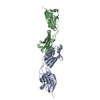 6nk3C  6nk6C  6nk7C M: map data used to model this data C: citing same article ( |
|---|---|
| Similar structure data | |
| Other databases |
- Links
Links
- Assembly
Assembly
| Deposited unit | 
|
|---|---|
| 1 | x 60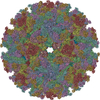
|
| 2 |
|
| 3 | x 5
|
| 4 | x 6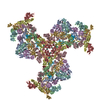
|
| 5 | 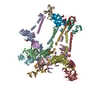
|
| Symmetry | Point symmetry: (Schoenflies symbol: I (icosahedral)) |
- Components
Components
| #1: Protein | Mass: 47346.715 Da / Num. of mol.: 4 / Fragment: UNP residues 810-1248 Source method: isolated from a genetically manipulated source Source: (gene. exp.)  Chikungunya virus (strain 37997) / Strain: 37997 / Cell line (production host): HEK293F / Production host: Chikungunya virus (strain 37997) / Strain: 37997 / Cell line (production host): HEK293F / Production host:  Homo sapiens (human) / References: UniProt: Q5XXP3 Homo sapiens (human) / References: UniProt: Q5XXP3#2: Protein | Mass: 46858.312 Da / Num. of mol.: 4 / Fragment: UNP residues 330-748 Source method: isolated from a genetically manipulated source Source: (gene. exp.)  Chikungunya virus (strain 37997) / Strain: 37997 / Cell line (production host): HEK293F / Production host: Chikungunya virus (strain 37997) / Strain: 37997 / Cell line (production host): HEK293F / Production host:  Homo sapiens (human) / References: UniProt: Q5XXP3 Homo sapiens (human) / References: UniProt: Q5XXP3#3: Protein | Mass: 16458.701 Da / Num. of mol.: 4 / Fragment: UNP residues 111-261 Source method: isolated from a genetically manipulated source Source: (gene. exp.)  Chikungunya virus (strain 37997) / Strain: 37997 / Production host: Chikungunya virus (strain 37997) / Strain: 37997 / Production host:  Homo sapiens (human) / References: UniProt: Q5XXP3 Homo sapiens (human) / References: UniProt: Q5XXP3#4: Sugar | ChemComp-NAG / Has protein modification | Y | |
|---|
-Experimental details
-Experiment
| Experiment | Method: ELECTRON MICROSCOPY |
|---|---|
| EM experiment | Aggregation state: PARTICLE / 3D reconstruction method: single particle reconstruction |
- Sample preparation
Sample preparation
| Component | Name: Chikungunya virus / Type: VIRUS / Details: Produced by PaxVax Corporation, Redwood CA, USA. / Entity ID: #1-#3 / Source: RECOMBINANT | ||||||||||||||||
|---|---|---|---|---|---|---|---|---|---|---|---|---|---|---|---|---|---|
| Molecular weight | Experimental value: NO | ||||||||||||||||
| Source (natural) | Organism:   Chikungunya virus / Strain: 37997 Chikungunya virus / Strain: 37997 | ||||||||||||||||
| Source (recombinant) | Organism:  Homo sapiens (human) / Cell: HEK293F Homo sapiens (human) / Cell: HEK293F | ||||||||||||||||
| Details of virus | Empty: YES / Enveloped: YES / Isolate: STRAIN / Type: VIRUS-LIKE PARTICLE | ||||||||||||||||
| Buffer solution | pH: 7.2 | ||||||||||||||||
| Buffer component |
| ||||||||||||||||
| Specimen | Conc.: 0.33 mg/ml / Embedding applied: NO / Shadowing applied: NO / Staining applied: NO / Vitrification applied: YES | ||||||||||||||||
| Specimen support | Details: 0.458 mbar.l/s O2 and 0.11 mbar.l/s H2 / Grid material: COPPER / Grid mesh size: 300 divisions/in. / Grid type: Quantifoil R2/2 | ||||||||||||||||
| Vitrification | Instrument: FEI VITROBOT MARK IV / Cryogen name: ETHANE / Humidity: 100 % / Chamber temperature: 277.15 K |
- Electron microscopy imaging
Electron microscopy imaging
| Experimental equipment |  Model: Titan Krios / Image courtesy: FEI Company |
|---|---|
| Microscopy | Model: FEI TITAN KRIOS |
| Electron gun | Electron source:  FIELD EMISSION GUN / Accelerating voltage: 300 kV / Illumination mode: FLOOD BEAM FIELD EMISSION GUN / Accelerating voltage: 300 kV / Illumination mode: FLOOD BEAM |
| Electron lens | Mode: BRIGHT FIELD |
| Image recording | Average exposure time: 0.3 sec. / Electron dose: 50 e/Å2 / Film or detector model: GATAN K2 SUMMIT (4k x 4k) |
- Processing
Processing
| EM software |
| ||||||||||||||||||||||||||||||||||||
|---|---|---|---|---|---|---|---|---|---|---|---|---|---|---|---|---|---|---|---|---|---|---|---|---|---|---|---|---|---|---|---|---|---|---|---|---|---|
| CTF correction | Type: PHASE FLIPPING AND AMPLITUDE CORRECTION | ||||||||||||||||||||||||||||||||||||
| Particle selection | Num. of particles selected: 8888 | ||||||||||||||||||||||||||||||||||||
| Symmetry | Point symmetry: I (icosahedral) | ||||||||||||||||||||||||||||||||||||
| 3D reconstruction | Resolution: 4.16 Å / Resolution method: FSC 0.143 CUT-OFF / Num. of particles: 8113 / Symmetry type: POINT | ||||||||||||||||||||||||||||||||||||
| Atomic model building | Protocol: FLEXIBLE FIT / Space: REAL | ||||||||||||||||||||||||||||||||||||
| Atomic model building | 3D fitting-ID: 1 / Source name: PDB / Type: experimental model
|
 Movie
Movie Controller
Controller



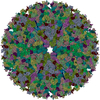
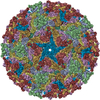
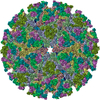
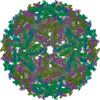
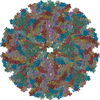
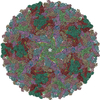



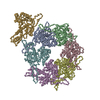
 PDBj
PDBj




